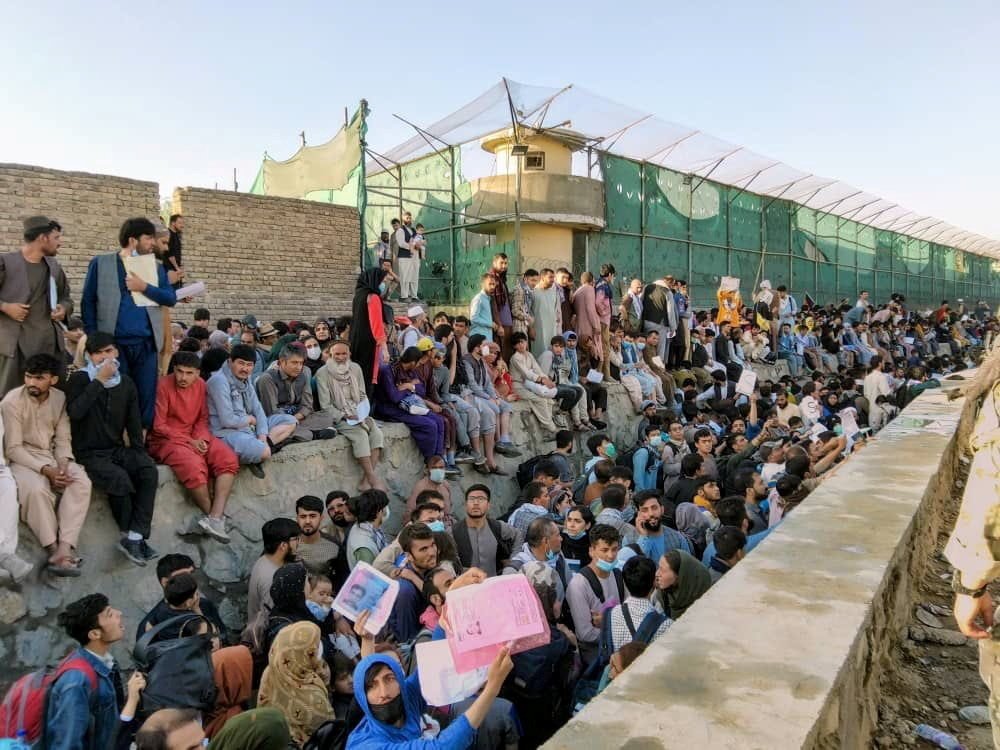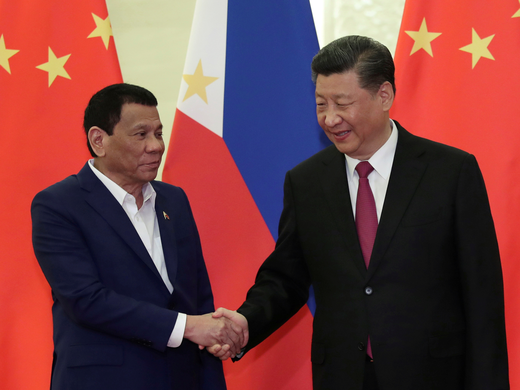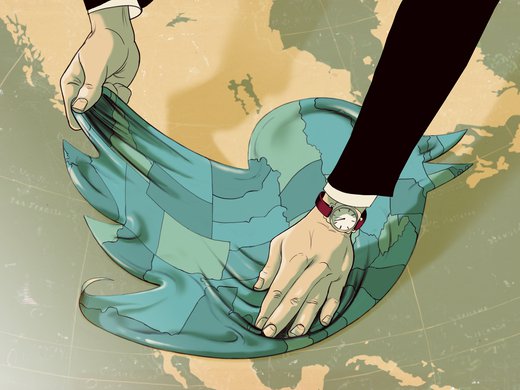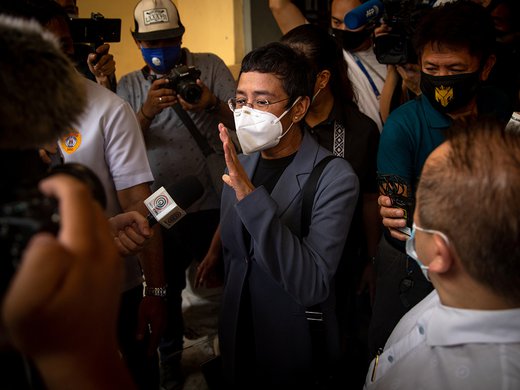We may live in an age of fast-paced, abundant information, but some images remain engrained in our memory. Watching Afghanistan fall to the Taliban, a few scenes stand out: a parent at the airport in Kabul, handing an infant over a fence to a US soldier; Afghans clinging to the wings and wheels of a moving US Air Force jet in a desperate attempt to flee. These photos were tweeted and retweeted on social media. This is what war — and defeat — look like in the digital age.
Many observers and policy makers appeared taken aback by how quickly Afghanistan fell. While heavy fighting took place in some areas, other cities collapsed with few shots being fired, including Kabul. There are complex reasons for this rapid collapse, including corruption and lack of resources. But several commentators and journalists have drawn attention to the role played by social media in the Taliban’s offensive. What does it mean to fight a war in the information era, and how much power do smartphones have in defeating the enemy?
It would be a gross overstatement and misunderstanding of the complexity of Afghan history and politics to suggest that the Taliban won the war thanks to social media, as former US State Department official Richard Stengel wrote. Nor did America “lose Afghanistan because of WhatsApp.” We must do away with these narratives. Social media and smartphones do not win a conflict. Instead, they are enablers. Nonetheless, according to observers on the ground, Taliban fighters “armed” smartphones to share footage of military advances and victories, which indicates they have a media and communication engagement strategy. On Twitter, there were images of Taliban fighters in the presidential palace in Kabul. The symbolism was clear: Kabul has fallen.
In 2021, Kalashnikovs are not sufficient to take over a country. In war, media communication and propaganda have long contributed to winning the hearts and minds of local populations. This is something the Taliban understood more than a decade ago. While the entity had a reputation for being technophobic — the group banned television and the internet in the 1990s — it became tech-savvy in the early 2000s. And although the Taliban’s ideology may appear “medieval,” their embrace of technology is not surprising. Like any political party, government or militant group in the information age, Taliban officials understand the advantages of online communication for political gain. In war, controlling the message — or propaganda — is crucial, and smartphones are simply the new tool, albeit perhaps more powerful than those of the past.
The Taliban launched its website, “Voice of Jihad,” more than a decade ago and created an official Twitter account in 2011. The aim was to win the approval of Afghans, as a Taliban media representative admitted: “Wars today cannot be won without media. Media is directed to the heart rather than the body, while the weapon is directed to the body. If the heart is defeated, the battle is won and the body is defeated.”
In war, media communication and propaganda have long contributed to winning the hearts and minds of local populations. This is something the Taliban understood more than a decade ago.
Far from operating in the shadows, Taliban militants use WhatsApp, Twitter, Facebook and Telegram. According to a recent study, in 2018, Taliban officials published more tweets than the Afghan government itself. Communicating in Pashto, Dari, Urdu, Arabic and English, Taliban social media accounts use different channels and platforms to communicate with audiences, including journalists and Afghans. The objectives were clear: one, justify the fight against the Afghan government and foreign troops; two, report military successes and demoralize enemies; three, promote the Taliban’s extremist Islamist ideology; and four, communicate with Afghan populations across the country.
Over the past few months, as the Taliban took city after city, militants deployed the encrypted app WhatsApp along with more public social media platforms to communicate with local populations, showcase military victories, coordinate advances with fighters and assume control over entire areas. When the group entered Kabul, they set up an emergency hotline on WhatsApp for Afghan civilians to report violence and looting.
For social media companies, the presence of Taliban officials and supporters on their platforms raises several dilemmas. What happens when a violent organization suddenly takes over a government and rules a country? (While the Islamic State used social media to its advantage, the terrorist group never managed to establish a state or take over a government.) Watching social media spokespeople last week, it was clear they were in full damage control.
The first question people may ask is why is a terrorist entity allowed on social media at all? If former US president Donald Trump is no longer allowed on Twitter and Facebook, how have Taliban representatives managed to remain online? The confusion and disparate policies among tech companies is partly due to the fact that, while the Taliban is designated a global terrorist entity by the US Treasury Department, the Afghan Taliban — unlike the Pakistani Taliban — is not listed on the US State Department’s Foreign Terrorist Organization list. Each social media company, therefore, has set up its own rules and policies.
Facebook spokespeople stated last week that because the Taliban is sanctioned as a terrorist organization by the US Treasury Department, its officials are banned from Facebook’s services (Instagram and WhatsApp included) under its Dangerous Organization policies. The company also said it has dedicated a team of experts to the task of monitoring and removing content supporting the Taliban.
Twitter seems to operate under slightly different rules since it pays more attention to the message content than to the affiliations of the account holder — which may allow Taliban representatives to evade scrutiny or remain online as long as they adhere to rules around hate speech and incitement of violence. YouTube, a unit of Google, appears to have no clear policies in place. Although the company bans terrorist promotional material and content, YouTube representatives first said there was no blanket ban on the Afghan Taliban, before reversing themselves.
The second question worth asking is how much these bans and policies were enforced since it is clear that Taliban officials and fighters had an online presence. Facebook (including WhatsApp), YouTube, and Twitter removed accounts belonging to Taliban spokesman Zabihullah Mujahid as the situation evolved last week. Another self-described Taliban spokesperson, Suhail Shaheen, continues to have an active and unverified account on Twitter with, at time of writing, 407,900 followers. The situation is even more complicated for WhatsApp, since the encrypted messaging app allows Taliban militants to escape scrutiny.
The capacity of Taliban officials to avoid social media bans shows they were able to operate within the rules of the platforms, including by avoiding content that would be deemed to be inciting hate speech and violence. Complicating the matter is the fact that Taliban supporters operate on multiple platforms and via various accounts, which means platforms must deal with a volume of content that is difficult to control. The Taliban’s takeover seems to have made the situation worse: according to The New York Times, more than 100 pro-Taliban accounts and videos have sprung up on Facebook, Twitter and YouTube over the past week. Banning Taliban officials is therefore only part of any solution, as supporters continue to disseminate their narrative. How are social media companies planning to deal with these accounts?
Since the Afghan government’s collapse, there seems to have been more of a crackdown. WhatsApp shut down the Taliban’s emergency hotline. Five Taliban-owned websites are no longer online, and, as earlier noted, Twitter has taken down the accounts of several Taliban officials. However, Twitter’s emerging practice seems to be to continue to allow some Taliban representatives on its platform as long as they nominally respect Twitter’s rules.
The Taliban’s online presence will continue to cause headaches. While the West grapples with whether to recognize a Taliban government, what can we expect countries such as China, Russia, Iran, and other strategic adversaries, or non-aligned countries, to do? Should we anticipate that the Taliban will eventually obtain some form of recognition from the international community? In that case, should a government be allowed on social media to communicate with citizens?
Facebook spokesman Andy Stone’s statement seemed to reflect this dilemma when he stated that “Facebook does not make decisions about the recognized government in any particular country but instead respects the authority of the international community in making these determinations.” Who is the international community? What will the United Nations decide, if anything?
Twitter may be even muddier waters since several world leaders, including Iranian president Hassan Rouhani, have official accounts. Furthermore, the company stated that its top priority is “keeping people safe” — but how safe are Afghan people? What will happen to those who do not agree with the Taliban? The group’s officials may claim they will not seek revenge and will let women work and be educated, but the Taliban’s record of ruthless brutality is established, and they are likely to impose their rules on people who resist. There were assassination campaigns in January. It is hard to see how the Taliban would suddenly change.
There already is evidence that Taliban militants are pursuing journalists, activists, moderate religious leaders, and Afghans who collaborated with the international coalitions. These people are not safe. Why else would they cling to planes departing Kabul airport? Furthermore, according to Rita Katz, the executive director of US-based SITE Intelligence Group, a non-governmental group that tracks online extremist activity, “The proliferation of the Taliban’s online infrastructure…is significantly contributing to the empowerment of global violent extremists.”
While Kalashnikovs and bombs remain the primary weapons of terror in Afghanistan, social media companies face an increasingly urgent ethical dilemma about the use of their platforms by Taliban officials and supporters. It’s a no-win situation for them. However, the group has committed many war crimes and human rights abuses. This is a matter of fact. They must be held accountable. So should the communications platforms that give them voice.



